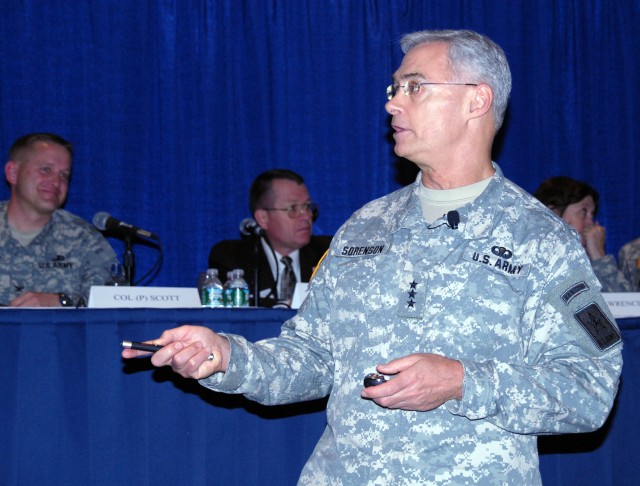
WASHINGTON (Army News Service, Oct. 8, 2009) -- Leadership from across the services Wednesday discussed the importance of making the Army's LandWarNet part of a joint enterprise.
Lt. Gen. Jeffery A. Sorenson, chief information officer/G-6, led the "Operationalizing LandWarNet Through the Global Network Enterprise Conflict Construct" panel at the Association of the United States Army Annual Meeting and Exposition.
Sorenson explained that the network will be transformed over the next three years to better support the Army and ultimately enable interoperability and collaboration between all the services.
'This can't be an Army deal," Sorenson said. "It's got to be a joint deal."
The Global Network Enterprise Construct is an Army-wide strategy that he said will transform LandWarNet -- the Army's portion of the Global Information Grid-- into an enterprise activity by focusing on four objectives: operationalizing LandWarNet, improving network defense, realizing efficiencies and improving effectiveness, and enabling interoperability with mission partners.
Navy Rear Adm. Elizabeth Hight, vice director of the Defense Information Systems Agency, spoke about the operational environment from the joint perspective. She stressed the importance of enabling the GNEC to operate at a joint level.
"It is in fact our partnership with Army, Navy, Air Force and Marine Corps that creates this global environment for the DoD warfighting forces to meet whomever their partner might meet ... along the range of keeping the peace to winning the war."
It is the goal of DISA to enable an E3 from any service to use the GIG and GNEC to conduct a mission seamlessly with the other forces, she said. "The joint world needs to leverage everything the U.S. Army has ... and vice versa," Hight said.
The Army tested this global capability when it put the 18th Fires Brigade out of Fort Bragg, N.C., on the GNEC for a training exercise, said Maj. Gen. Susan Lawrence, commanding general of NETCOM. During the exercise, the unit was able to connect to the fixed regional hub-node in Landstuhl, Germany, from a command post node in a field location.
When the unit simulated a move to Europe, all the information it needed, right down to individual identities, was stored at FRN in Landstuhl. When the unit "arrived" it was able to plug back in and bring up all the needed information seamlessly, she said.
"Why is that a big deal'" Lawrence asked. Before, the information would take months to catch up to a unit, and would be outdated when it arrived.
"In this scenario, they fought on the network, with their information on the network. We never changed their e-mail address, we never changed their phone number, and they had immediate access to their data at any given time," she said.
Essentially, the exercise proved the concept of the GNEC is feasible - it is not a technical challenge, but rather a cultural challenge, Lawrence explained.
"It's all about this: improving that situational awareness," Sorenson said. The GNEC will help provide shared situational awareness to warfighters across the services, as well as a continuity of information for units always on the move.

Social Sharing